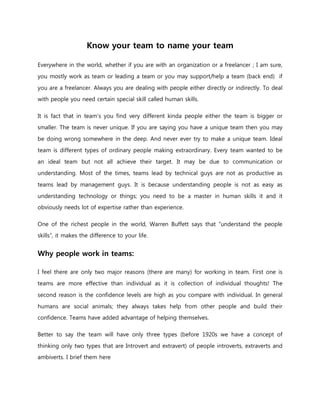
Team and team!
- 1. Know your team to name your team Everywhere in the world, whether if you are with an organization or a freelancer ; I am sure, you mostly work as team or leading a team or you may support/help a team (back end) if you are a freelancer. Always you are dealing with people either directly or indirectly. To deal with people you need certain special skill called human skills. It is fact that in team’s you find very different kinda people either the team is bigger or smaller. The team is never unique. If you are saying you have a unique team then you may be doing wrong somewhere in the deep. And never ever try to make a unique team. Ideal team is different types of ordinary people making extraordinary. Every team wanted to be an ideal team but not all achieve their target. It may be due to communication or understanding. Most of the times, teams lead by technical guys are not as productive as teams lead by management guys. It is because understanding people is not as easy as understanding technology or things; you need to be a master in human skills it and it obviously needs lot of expertise rather than experience. One of the richest people in the world, Warren Buffett says that “understand the people skills”, it makes the difference to your life. Why people work in teams: I feel there are only two major reasons (there are many) for working in team. First one is teams are more effective than individual as it is collection of individual thoughts! The second reason is the confidence levels are high as you compare with individual. In general humans are social animals; they always takes help from other people and build their confidence. Teams have added advantage of helping themselves. Better to say the team will have only three types (before 1920s we have a concept of thinking only two types that are Introvert and extravert) of people introverts, extraverts and ambiverts. I brief them here
- 2. 1) Introverts: People who fall into this category are good at understanding other people. They are very good at perceive not only “people” also the people’s ideas. And believe it or not, they are the inventors, go getters and change makers. Good listeners and great workers. Most of the scientists fit to this category, even Albert Einstein world famous introvert (by Forbes). They have explored the world and made it easier and have been exploring to make more comfort. You know if you observe most of the leaders/managers fall into this category. They speak necessary. These are damn good at discussing and they never ever and ever argue with anybody. They go with win- win situation. (I even written an article may be a couple of months back outside the cognizant blogging click here to go through it). These are highly energetic and extremely productive. The problem with these guys is, they shy to speak and they always take more time in making friends/mingle with strangers. The punch is you might not have observed this most of you are working under an introvert manager.
- 3. 2) Extroverts: People who fall into this category are (“blah blah”) interested and concerned with the external world. An extrovert is a person who is energized by being around other people. Extroverts love to talk, but it's up to you to limit how much time they waste (your) time. Extraversion is a core factor and it is difficult to modify. http://healthland.time.com/2012/01/27/the-great-introverts-and-extroverts-of-our-time/ 3) Ambiverts: Ambiverts are the people neither (extremely) introverts nor (extremely) extroverts. They fall in between. This new category introduced in 1920 by social scientists in USA. If you take three categories on 1-to-10 scale, ambiverts are not 1s or 2s and not 9s 0r 10s either. They are in 5s or 6s. They are not quiet but they are not too loud. These people are very good at sales. Most people think extroverts very much fit to sales and marketing but the fact is not. 4) Other: Apart from these three categories there is other type of people exist in most of the teams. They just speak to show their presence. That may be relevant or irrelevant. They always try to drag the conversation (JLT). There will be nothing to discuss but they will misguide the conversation to log the file. I am sure that they never realize that they are killing others time, in fact their own valuable time. What is an ideal team? Now I think you are able to answer what is an ideal team. The fact is, when it comes to working with a team, there is no one size (entity) fits all communication style. Introverts,
- 4. extroverts and ambiverts require different approaches and contribute differently to the team. The main thing here is to keep in mind, is everybody (whether he is an introvert or extrovert) has importance. Everybody is equal. If the managers want to make a difference, they have to know how to balance these three/four (sometimes this fourth category may not exist in teams) categories. As I already mentioned that you need to be a master to balance your team. Reading books, observing patterns and listening to speeches will always help you. Buy guys!
